This special issue contains research which navigates the territory between the real and virtual world through metaphor, cognitive model, data stream and a designer’s synergy. (…) In this volume of IJDC we attempted to solicit and select papers that explore that overlapping boundary between the physical and the virtual. In particular, we looked for research that contemplated the role of the subject user versus the machine automaton. The first paper from Maher, Gero, Smith, and Gu’s utilizes agents that sense their environment and react accordingly. What is of particular interest is in how those artificial agents responded to users who inhabit their world. The Heylighen and Segers’ DYNAMO articleBermudez cyberPRINT, a dancer interacts with the virtual manifestation of his physiological data. The performance aims to closely couple the human physical condition and the virtual condition such that, eventually, the boundaries between them are blurred. The article from Fischer and Fischer appropriates a morphogenetic biologic model to digital form finding. The human, in this case acts as a director shaping and nudging largely independent virtual actors. It is in the lack of complete control that we find such systems intriguing...
Sep 21, 2005
Brainmirror
Via dataisnature
BrainMirror is an interactive experience where the image of the visitors brain appears mixed with his/her mirror image, using natural head movement as an interface to explore volumetric visuals of the human brain. 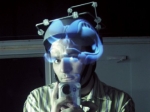 How it works? a motion tracker computer watches the audience through four fire-wire cameras equipped with infra-red filters. The helmets are mounted with super-bright infra-red LED's, each modulating it's brightness with it's own unique finger-print id-code.
How it works? a motion tracker computer watches the audience through four fire-wire cameras equipped with infra-red filters. The helmets are mounted with super-bright infra-red LED's, each modulating it's brightness with it's own unique finger-print id-code.
Download video (32Mb Quicktime)
15:41 Posted in Cyberart | Permalink | Comments (0) | Tags: Positive Technology
Sep 19, 2005
Between the physical and the virtual
via Pasta & Vinegar
The International Journal of Design Computing has a special Issue on the Space Between the Physical and the Virtual:
18:05 Posted in Positive Technology events | Permalink | Comments (0) | Tags: Positive Technology
The added value of eHealth
The International EHTEL conference titled Improving Care for Chronic Conditions - the added value of eHealth will take place in Rome, 10-11 October 2005, jointly organised by EHTEL, the National Research Council of Italy, Institute for Biomedical Technology in co-operation with ESQH and NIZW.
Keynotes of internationally recognised experts and contributions selected by an international Program Committee will be complemented by stakeholder views and open round table panels.
15:16 Posted in Positive Technology events | Permalink | Comments (0) | Tags: Positive Technology
Collective intelligence - The Transitioner
Down through the media, overhead machineries will make us hear the voice of the multiple. Still indiscernible, soften by the hazes of the future, flooding another humanity with its murmur, we have an appointment with the surlanguage
Pierre Lévy – "Collective Intelligence"
 The Transitioner.org is wiki which brings together those who want to marry the economy and Collective Intelligence in order to build a fair world.
The Transitioner.org is wiki which brings together those who want to marry the economy and Collective Intelligence in order to build a fair world.
Discover here if you are a transitioner (I discovered I am)
More to explore
Blog of Collective Intelligence
Improving the efficiency of social ecosystems
13:05 Posted in Social Media | Permalink | Comments (0) | Tags: Positive Technology, complex networks
Video games promoted as effective health-care training
Games for Health is a project produced by Serious Games Initiative to promote best practices, community building, and research into how cutting-edge game design and development methodologies can aid in the creation of health tools that range from direct patient application, to personal health education, and workforce initiatives.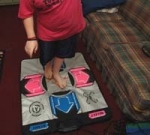
Examples of these applications include the following:
- Dance Dance Revolution: The popular dance game from Konami features an exercise mode. You set goals and play while it reports calorie burn from game sessions.
- In The Netherlands, VSTEP (Virtual Safety Training and Education Platform) has enjoyed success developing 3-D simulations for low-cost PC hardware. The "virtual experiences" are used for training oil-rig workers, emergency services, port authorities, hospital staff and military.
- Cardiac Arrest: A computer adventure game that simulates the diagnosis and treatment procedures for people suffering from various forms of cardiac arrest.
- VR Phobia: The Virtual Reality Medical Center has modified commercial games to create effective treatments for patients suffering from common phobias, including fear of flying, spiders, heights, and driving.
More to explore:
The “Serious Games Summit” is being held October 31st - November 1st, 2005, in Washington D.C. Areas of discussion range from the military and government, to health and education.
http://www.seriousgamessummit.com/home.html
“Games For Health 2005″, September 22-23, 2005, Baltimore, Maryland.
http://www.gamesforhealth.org/events.html
11:55 Posted in Serious games | Permalink | Comments (0) | Tags: serious gaming
Sep 17, 2005
View of cell-phone activity in Graz
via Future Feeder
Digital Derive is a platform developed senseable city lab that allows to visualize the volume & geographic source of cell phone usage in Graz, showing a visual conceptual layer in the use & experience of the city.
 From the lab web site:
From the lab web site:
Digital Derive harnesses the potential of mobile phones as an affordable, ready-made and ubiquitous medium that allows the city to be sensed and displayed in real-time as a complex, pulsating entity. Because it is possible to simultaneously 'ping' the cell phones of thousands of users - thereby establishing their precise location in space at a given moment in time - these devices can be used as a highly dynamic tracking tool that describes how the city is used and transformed by its citizens. The polis is thus interpreted as a shifting entity formed by webs of human interactions in space-time, rather than simply as a fixed, physical environment. Digital Derive provides a platform upon which the contemporary city can register the flux and traces its self-constructing and open-ended nature. Previous initiatives, notably Laura Kurgan's 'You Are Here: Museu' (1996) and the Waag Society's 'Amsterdam Real-Time' (2002) initiated this process by exploring the qualities and potential of GPS technology. Digital Derive builds on an expands these efforts by using cell phone technology, for the first time, to radically increase the interactive capacity and number of users involved in the mapping of the city. Digital Derive (re)presents the city displayed simultaneously in the Kunsthaus Graz and in a publicly accessible website.
19:55 Posted in Information visualization | Permalink | Comments (0) | Tags: Positive Technology, complex networks
Sep 16, 2005
Non-invasive neural interface technology
Via Engadget (thanks to Giuseppe Riva)
NeuroSky Inc. claims to have developed a non-invasive neural sensor and signal processing technology that converts brainwaves and eye movements into electronic signals to control a range of electronic devices.
According to Neurosky, neural interface technology promises to simplify cell phone-based applications that today require error-prone human input, as well as revolutionize applications from gaming to medical diagnostics and therapy.
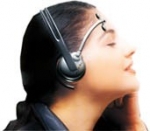 EETimes reports that five companies, including a Bluetooth headset provider, game console maker and trucking company, have signed up to market end-user products containing NeuroSky's chips.
EETimes reports that five companies, including a Bluetooth headset provider, game console maker and trucking company, have signed up to market end-user products containing NeuroSky's chips.
From the company website:
NeuroSky, a fabless semiconductor/module company, has developed a non-invasive neural sensor and signal processing technology that converts brainwaves and eye movements into useful electronic signals to communicate with a wide range of electronic devices, consoles, and computers. While brainwaves have been used as a form of diagnostics and therapy in neurosciences for years, the related technology has never reached a large audience due to price/size constraints, inconvenient physical limitations, and/or invasive surgical procedures. NeuroSky draws from this research and adapts it to commercialize neural interface technologies for various attractive global markets.
More to explore
13:00 Posted in Brain-computer interface | Permalink | Comments (0) | Tags: Positive Technology, brain-computer interface
Sep 15, 2005
ICare Haptic Interface for the blind
Via the Presence-L Listserv
(from the iCare project web site)
iCare Haptic Interface will allow individuals who are blind to explore objects using their hands. Their hand movements will be captured through the Datagloves and spatial features of the object will be captured through the video cameras. The system will find correlations between spatial features, hand movements and haptic sensations for a given object. In the test phase, when the object is detected by the camera, the system will inform the user of the presence of the object by generating characteristic haptic feedback. I Care Haptic Interface will be an interactive display where users can seek information from the system, manipulate virtual objects to actively explore them and recognize the objects.
The system will find correlations between spatial features, hand movements and haptic sensations for a given object. In the test phase, when the object is detected by the camera, the system will inform the user of the presence of the object by generating characteristic haptic feedback. I Care Haptic Interface will be an interactive display where users can seek information from the system, manipulate virtual objects to actively explore them and recognize the objects.
More to explore
15:35 Posted in Future interfaces | Permalink | Comments (0) | Tags: Positive Technology, Future interfaces
Mind & Life XIII
The Mind & Life Institute presents: MIND & LIFE XIII Co-hosted by Georgetown University Medical Center and The Johns Hopkins University School of Medicine. The Dalai Lama will participate fully in all sessions.
The Science and Clinical Applications of Meditation DAR Constitution Hall, Washington DC November 8 - 10, 2005 Jointly sponsored by The Mind & Life Institute and CME-accredited by Georgetown University Hospital. The conference builds on the growing interest in meditation within modern medicine and biomedical science that has arisen over the past thirty years and further explores the emerging clinical opportunities.
Conference Sessions
1. Meditation-Based Clinical Interventions: Science, Practice, and Implementation
2. Possible Biological Substrates of Meditation
3. Clinical Research I: Meditation and Mental Health
4. Clinical Research II: Meditation and Physical Health
5. Integration & Final Reflections
Speakers
Ajahn Amaro, B.Sc. — Abhayagiri Monastery
Richard J. Davidson, Ph.D. — University of Wisconsin-Madison
Jon Kabat-Zinn, Ph.D. — U. of Mass. Medical School, Emeritus
Daniel Kahneman, Ph.D. — Princeton University
Helen S. Mayberg, M.D. — Emory University
Robert M. Sapolsky, Ph.D. — Stanford University
Zindel V. Segal, Ph.D. — University of Toronto
David S. Sheps, M.D. — University of Florida
John F. Sheridan, Ph.D. — Ohio State University
Wolf Singer, M.D., Ph.D. — Max-Planck-Institut für Hirnforschung
Ralph Snyderman, M.D. — Duke University Medical Center
Panelists
Jan Chozen Bays, M.D. — Great Vow Zen Monastery
Joan Halifax, Ph.D. — Upaya Zen Center
Father Thomas Keating, OCSO — St. Benedict's Monastery
Margaret E. Kemeny, Ph.D. — University of California-SF
Jack Kornfield, Ph.D. — Spirit Rock Meditation Center
Matthieu Ricard, Ph.D. — Shechen Monastery
Sharon Salzberg, R.N. — Insight Meditation Society
Bennett M. Shapiro, M.D. — Merck Research Laboratories, Emeritus
Esther M. Sternberg, M.D. — National Institute of Mental Health
John D. Teasdale, Ph.D. — MRC Cog. & Brain Sci. Unit, Emeritus
B. Alan Wallace, Ph.D. — Santa Barbara Institute
Mind and Life Dialogues
Mind and Life Institute XIII is the latest in a series of dialogues between scientists, the Dalai Lama, and other Buddhist contemplatives on areas of mutual interest at the intersection of western empirical science and the contemplative traditions and their associated methodologies, psychologies, and philosophies. Prior to 2003, all of these meetings have been held in private; however books describing them have been published and are widely available. Investigating the Mind 2005: The Science and Clinical Applications of Meditation is the second Mind and Life Dialogue that will be open to a large audience, consisting primarily of people working in the fields of medicine, clinical psychology, psychiatry, and neuroscience, as well as students in these fields.
14:57 Posted in Positive Technology events | Permalink | Comments (0) | Tags: Positive Technology
Sep 14, 2005
The Stress Eraser
Via Medgadget
The Stress Eraser from Helicor claims to reduce cronic stress. Designed by Frog design, Stress Eraser is a standalone device that induces relaxation through breathing exercises programmed in. 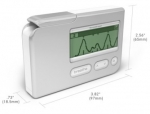
I prefer a glass of wine, but the design is nice-looking
13:25 Posted in Emotional computing | Permalink | Comments (0) | Tags: Positive Technology, Emotional technology
Sep 12, 2005
Social Networks as Health Feedback Displays
In this paper published on September/October issue of IEEE Pervasive Computing Journal Margaret E. Morris describes how social-networking and pervasive computing technologies can be used to help reduce feelings of social isolation and depression in elderly individuals. 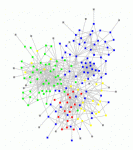 In this approach, sensor data measuring phone calls and visits are used to derive public displays of social interactions with relatives and friends, which they introduced into select elders’ homes. According to Morris and colleagues, as people see their social interactions illustrated in these feedback displays, their feeling of social isolation is reduced.
In this approach, sensor data measuring phone calls and visits are used to derive public displays of social interactions with relatives and friends, which they introduced into select elders’ homes. According to Morris and colleagues, as people see their social interactions illustrated in these feedback displays, their feeling of social isolation is reduced.
Margaret E. Morris. "Social Networks as Health Feedback Displays," IEEE Pervasive Computing Journal, vol. 9, no. 5, pp. 29-37, September/October 2005.
Abstract
Social networks have thus far served primarily as analytic tools for social scientists. Leveraging pervasive computing, this new research transforms social-network models into behavioral feedback displays. These ambient displays, which reflect data on remote and face-to-face interaction gathered by wireless sensor networks, were intended to raise awareness of social connectedness as a dynamic and controllable aspect of well-being. An interdisciplinary health technology research group at Intel recently developed and tested prototypes in the homes of older adults and their caregivers. This article reviews the psychological rationale for the project and highlights some reactions of participants to the displays.
15:20 Posted in Information visualization | Permalink | Comments (0) | Tags: Positive Technology, complex networks
Virtual goggles can help alleviate patients' anxiety during dental procedures
Via Wired
Dentists are starting to use eyeglass systems for easing patients' anxiety and pain during dental procedures. Introducing a distraction has long been known to help reduce pain for some people during surgical operations. 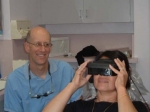 Because virtual reality is a uniquely effective new form of distraction, it makes an ideal candidate for pain control.
Because virtual reality is a uniquely effective new form of distraction, it makes an ideal candidate for pain control.
More to explore
Virtual reality in pain therapy
15:15 Posted in Cybertherapy | Permalink | Comments (0) | Tags: Positive Technology, virtual reality
Sep 09, 2005
International Journal of Human-Computer Studies - Special issue on computer support for creativity
October issues (4-5, Pages 363-536) of the International Journal of Human-Computer Studies focus on the different ways that computers can be involved in creative work.
The journal covers research in computing, artificial intelligence, psychology, linguistics, communication, design, engineering, and social organization, which is relevant to the design, analysis, evaluation and application of innovative interactive systems.
11:15 Posted in Creativity and computers | Permalink | Comments (0) | Tags: Positive Technology, research tools
Sep 08, 2005
Imagery-induced Cortical Excitability Changes in Stroke
Results of this focal transcranial magnetic stimulation study recently published on Cerebral Cortex by a team of Italian neuroscientists suggest that motor imagery could induce a pronounced motor output enhancement in the hemisphere affected by stroke. These findings strongly support the use of motor imagery as a therapeutic mean in post-stroke motor rehabilitation.
Cicinelli P, Marconi B, Zaccagnini M, Pasqualetti P, Filippi MM, Rossini PM.
Cerebral Cortex, 2005 May 4 (Epub ahead of print)
Focal transcranial magnetic stimulation (TMS) was employed in a population of hemiparetic stroke patients in a post-acute stage to map out the abductor digiti minimi (ADM) muscle cortical representation of the affected (AH) and unaffected (UH) hemisphere at rest, during motor imagery and during voluntary contraction. Imagery induced an enhancement of the ADM map area and volume in both hemispheres in a way which partly corrected the abnormal asymmetry between AH and UH motor output seen in rest condition. The voluntary contraction was the task provoking maximal facilitation in the UH, whereas a similar degree of facilitation was obtained during voluntary contraction and motor imagery in the AH. We argued that motor imagery could induce a pronounced motor output enhancement in the hemisphere affected by stroke. Further, we demonstrated that imagery-induced excitability changes were specific for the muscle 'prime mover' for the imagined movement, while no differences were observed with respect to the stroke lesion locations. Present findings demonstrated that motor imagery significantly enhanced the cortical excitability of the hemisphere affected by stroke in a post-acute stage. Further studies are needed to correlate these cortical excitability changes with short-term plasticity therefore prompting motor imagery as a 'cortical reservoir' in post-stroke motor rehabilitation.
12:45 Posted in Mental practice & mental simulation | Permalink | Comments (0) | Tags: Positive Technology, mental practice, motor imagery
5th International Conference on Affective Computing and Intelligent Interfaces
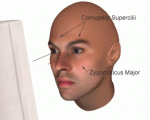
12:15 Posted in Positive Technology events | Permalink | Comments (0) | Tags: Positive Technology
Sep 07, 2005
International Conference on Smart homes and health Telematics
The 2006 edition of ICOST - International Conference on Smart homes and health Telematics - will take place June/July 2006 in Belfast, Northern Ireland. ICOST aims at creating an active research community dedicated to explore how smart homes in particular and health telematics in general can foster independent living and an enhanced life style for elderly and disabled people.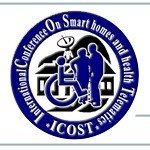
Conference Programme:
- Conference dates: June / July 2006
- Submission of Abstracts (2-4 pages): February 15th 2006
- Notification to authors: March 15th 2006
- Camera Ready Papers: April 15th 2006
11:15 Posted in Positive Technology events | Permalink | Comments (0) | Tags: Positive Technology
The Blue Brain Project
The “Blue Brain” project, a collaboration between IBM and the Ecole Polytechnique Fédérale de Lausanne (EPFL), aims to create the first computer simulation of the circuitry in the neocortex, which is the largest and most complex part of the human brain, down to the molecular level. 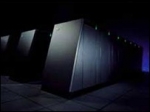
For the project, IBM will use the latest installation of IBM's BlueGene/L system running on Linux. EPFL's supercomputer uses 8.000 CPUs and has a peak speed of 22.8 teraflops (22.8 trillion calculations every second) putting it among the the world's top 15 supercomputers. The simulation code will be based on NeoCortical Simulator, an open source software running on Linux developed by Dr. Philip Goodman's.
Using the digital model generated by Blue Brain, scientists hope to shed light on complex cognitive processes such as thought, perception and memory, and to understand more about mechanisms responsible of brain malfunction.
More to explore
IBM Research Blue Gene Project Page
10:55 Posted in Research tools | Permalink | Comments (0) | Tags: Positive Technology, research tools
Sep 06, 2005
Intel Proactive Health Research
Can proactive systems that anticipate a patient's needs improve the quality of life for both the patients and their caregivers? Intel's Proactive Health Research group looks at how ubiquitous computing can be used in the health care industry and specifically how current technologies can be applied to help take care of the quickly growing population of senior citizens.
The project, launched in April 2002, consists of three phases:
- Phase One: Focus on physical and cognitive decline, especially on technologies that will help tomorrow's elderly population to age in place from wherever they and their families choose
- Phase Two: Address the needs of those with common chronic conditions like cancer and cardiovascular disease.
- Phase Three: Focus on wellness, including nutrition, physical fitness, and mental health.
More to explore
Intel's Proactive Health Research Initiative website
12:45 Posted in Brain training & cognitive enhancement | Permalink | Comments (0) | Tags: Positive Technology, Cognitive prosthetics
Sep 05, 2005
Meditation alters perceptual rivalry in Tibetan Buddhist monks
reported in the June 7 issue of Current Biology their results from a series of experiments with 76 monks in Ladakh. The goal of their research was to investigate how certain type of meditation can Researchers found that the skills developed by Tibetan Buddhist monks in their meditation practice strongly influence their experience of binocular rivalry, a perceptual phenomenon that occurs when the brain alternates between viewing different images presented to each eye. The neural processes underlying perceptual rivalry are still unclear but they are thought to be linked with brain mechanisms that regulate attention and conscious awareness.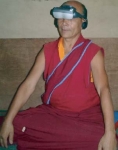
76 Tibetan Buddhist monks participated in the study. The researchers tested the experience using binocular goggles that prompt visual rivalry. The researchers found that the use of a specific meditation technique, called “one-point meditation” determined a high rate of perceptual dominance. In other words, when they used that technique the normal switching processes of binocular rivalry slowed considerably. This observation suggests that individuals who have trained themselves in meditation techniques can alter the normal fluctuations in the states of their consciousness.
More to explore
Carter, O.L., Presti, D.E., Callistemon, C., Ungerer, Y., Liu, G.B., and Pettigrew, J.D. (2005). Meditation alters perceptual rivalry in Tibetan Buddhist monks. Current Biology, Vol. 15, June 7, 2005, pp. 412-413.
16:20 Posted in Meditation & brain | Permalink | Comments (0) | Tags: Positive Technology, meditation
Laser-based tracking for HCI
Via FutureFeeder
Smart Laser Scanner is a high resolution human interfaces that tracks one’s bare fingers as it moves through space in 3Ds. Developed by Alvaro Cassinelli, Stephane Perrin & Masatoshi Ishikawa, the system uses a laser, an array of moveable micro-mirrors, a photodector (an instrument that detects light), and special software written by the team to collect finger-motion data. 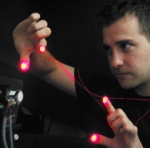 The laser sends a beam of light to the array of micro-mirrors, which redirect the laser beam to shine on the finger tip. A photodector senses light reflected off the finger and works with the software to minutely and quickly adjust the micro-mirrors so that they constantly beam the laser light onto the fingertip. According to Cassinelli and his co-workers, the system's components could be eventually integrated into portable devices.
The laser sends a beam of light to the array of micro-mirrors, which redirect the laser beam to shine on the finger tip. A photodector senses light reflected off the finger and works with the software to minutely and quickly adjust the micro-mirrors so that they constantly beam the laser light onto the fingertip. According to Cassinelli and his co-workers, the system's components could be eventually integrated into portable devices.
More to explore
The Smart Laser Scanner website (demo videos available for download)
15:25 Posted in Future interfaces | Permalink | Comments (0) | Tags: Positive Technology, Future interfaces







